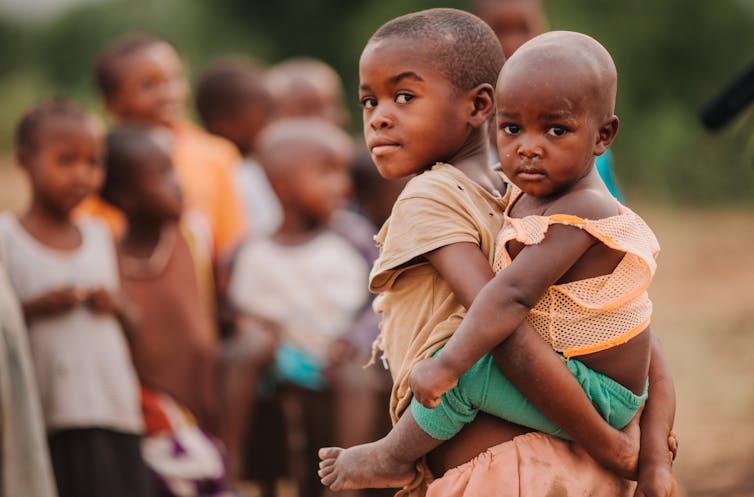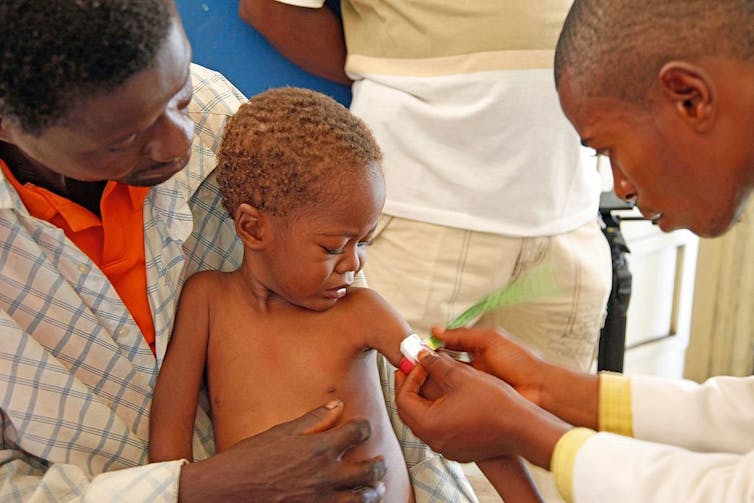
Marco Pomati, Cardiff University and Shailen Nandy, Cardiff University
Four years ago the United Nations (UN) members states created a list of international development targets, known as the Sustainable Development Goals. These included 17 urgent calls for action aimed at improving the lives of people around the world. Tackling poverty and food insecurity were placed at the top of the list.
One region where hunger and poverty continue to blight the lives of millions, affecting the survival and development of children in particular, is in West and Central Africa.
For the UN to develop effective policies for reducing persistent poverty and hunger, they first needed a clear picture of the scale of the crisis, – including how many children are still affected by malnutrition. Our project explored whether the measures used in UN reports provide an accurate picture of the full scale of malnutrition, and progress made, in West and Central Africa.
Our results suggest that the numbers currently used to estimate malnutrition underplay the true extent of the problem. We believe current indicators underestimate the overall extent of malnutrition among young children in the region by at least 6m children.
Assessment challenges
Our analysis used data on young children under five years old collected by USAID’s Demographic and Health Survey and UNICEF’s Multiple Indicator Cluster Surveys. We looked at data from the 18 countries in the West and Central Africa.
The project produced the first estimates of the extent and number of children in the region experiencing any form of anthropometric failure – meaning their physical development was stunted due to poor nutrition. Children with anthropometric failure are either too short or too light for their age, or too light for their height. These forms of malnutrition are known as stunting, underweight and wasting, respectively.
Children can experience each form of malnutrition, either on its own or in combination. Children experiencing two or more of these forms were classified as having multiple malnutrition. Our project was the first to produce detailed estimates of multiple malnutrition for countries in the region, and the region as a whole.
One reason why conventional estimates of child malnutrition understate the extent of the problem is because of the indicators used. The Millennium Development Goals assessed progress until 2015 using data on the number and proportion of children who were underweight.
The Sustainable Development Goals are tracking progress until 2030. They’re looking at the number and proportion of children who experience stunting (their height was lower than expected for their age), and wasting (their weight for their height is less than expected). Stunting reflects chronic, longer-term malnutrition, while wasting is an indicator of more recent, acute malnutrition. Tracking progress over time using different indicators can be confusing – especially when they tell quite different stories of extent and trends.
Our study used a measure of overall malnutrition called the Composite Index of Anthropometric Failure (CIAF). This identifies children who experience any form of malnutrition – whether it’s stunting, wasting, being underweight, or any combination of these.

The CIAF provides more accurate estimates of what proportion of a nation’s young children suffer from malnutrition because it can identify children suffering with any form of malnutrition. Other indicators, like those used in UN reports, do not do this.
For example, the Millennium Development Goals only used being underweight as a indicator of malnutrition. This means it missed stunted children who might not be underweight. Children who experience wasting but aren’t stunted (and vice versa) might also not be underweight. This means they’re also overlooked.
Similarly, the Sustainable Development Goals currently report the percentage of stunted children and wasted children separately. This means that we still lack estimates of the number of children who experience either stunting, wasting or who are underweight, or a combination of these measures. The CIAF overcomes this problem.
Monitoring children who suffer from multiple malnutrition is also important as different forms of malnutrition have different mortality risks. While the CIAF shows the true extent of overall undernutrition, the indicator of multiple malnutrition shows how many children experience multiple anthropometric failures, who are at greatest risk of an early death.
The scale of multiple malnutrition
Our study shows that estimates of child malnutrition vary considerably depending on the indicator used. At the regional level in 2010, there were around 15.5m underweight children (23%). Around 26.4m children experienced stunting (38%), and 8.2m children experienced wasting (12%). However, when we used the CIAF, we found nearly half (48%) of the region’s children under five (about 32.8m) were affected.
This shows that conventional estimates of malnutrition for the region effectively overlooked millions of malnourished children. As such, current UN estimates don’t fully reflect the extent of the problem in the region.
Though other studies have looked at multiple malnutrition, they may also be underestimating the extent of the problem. Many focus specifically on stunting and wasting, so they may neglect valuable information provided by underweight data.
These studies on multiple malnutrition have also only counted children experiencing both stunting and wasting, who are at greatest risk of poor health and death. Using a joint measure of stunting and wasting, we estimate that in 2010, around one in 25 children in West and Central Africa (4%, or 2.5m) were affected, suggesting that multiple malnutrition is relatively rare.
However, previous studies have also demonstrated that children who experience stunting and who are underweight, or who experience wasting and who are underweight, also have a greater risk of illness and early death compared to children who experience only a single failure. Our work provides evidence to support this.
By excluding data on underweight children from estimates (as the Sustainable Development Goals are doing), many vulnerable children will continue being overlooked. Using the CIAF to measure multiple malnutrition, we estimate that around one in five (22%, 9.2m) children under five in the region were affected by multiple malnutrition in 2010. We believe the extent of multiple malnutrition in children is more common than realised, which is something policy makers should be made aware of.
Our study also shows how the situation changed during the first decade of the new millennium. Using data for countries with multiple surveys, we show that between 2000 and 2010 progress in reducing child malnutrition in West and Central Africa wasn’t enough to outrun rapid population growth. By 2010 there were an additional 2.5m malnourished children in the region compared to five years previously. Prevalence rates also hadn’t fallen significantly.
Of the additional 2.5m malnourished children, more than half lived in rural areas. However, large urban population increases meant that urban areas contributed around a million children to the higher regional figures.
Policy makers need reliable data to develop antipoverty policies. Generating new information about the extent and pattern of malnutrition in some of the world’s poorest countries might spur governments and international agencies into action, providing the resources needed to make lasting change in some of the poorest countries on the planet.![]()
Marco Pomati, Lecturer, Cardiff University and Shailen Nandy, Reader in the School of Social Sciences, Cardiff University
This article is republished from The Conversation under a Creative Commons license. Read the original article.

